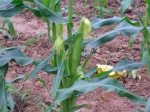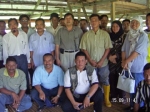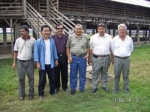Mar 15, 2009
Farm Visit March 15, 2009
Retailers and customers of DQ Chicken came to the farm today to see for themselves how the farm is managed, and the farming methods used.
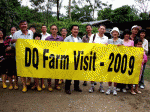
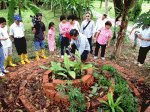
The herb spiral drew interest
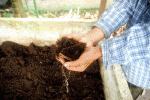

For the priviledge of visiting the farm, you have to smell this compost made of dung, carcasses and dried leaves and branches.
You also have to smell a still used chicken litter that has not been removed for 7 years, from one of the coops.

Feeling the Qi

Looking for Qi
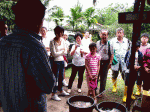
Qi Tea for spraying on plants
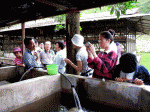
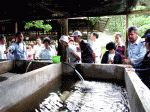
High productivity aquaculture - one tiny pond such as this can fetch a revenue of RM10,000 per cycle of 6 months.
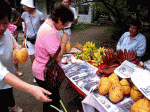
Then fruits from the farm for everybody.
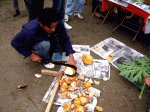
Coconuts to quench your thirst after a hot day walking around.
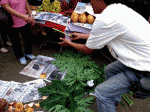
Here's a straw from a papaya leaf stem to drink your coconut water with.
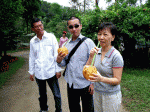
Yummy, perfect end to a hot day.
18:53 Posted in Visitors | Permalink | Comments (2) | Tags: sustainable farming, organic farming, farm visits, nature farming
Apr 14, 2006
Nature Q-Farming
This bush of creepers were all green. Within two weeks of spraying our bio-nutrients, it started to flower abundantly.
Our high Qi compost and compost tea produces abundant crops without the use of chemicals. Here is a maize plant with four ears after we sprayed our tea. This particular type normally have one or two ears. The plant is only about 3 feet high.

Even heliconias at our farm flower incessantly and in abundance.
15:15 Posted in Bio Nutrients | Permalink | Comments (0) | Tags: Organic Farming
Apr 10, 2006
Qi Cucumbers
We were selling our first crop of organic cucumbers and customers were asking whether we have those mini Taiwanese cucumbers. We were puzzled for a while as we thought we were selling Taiwanese minis. Now we realised that due to our bio nutrients and high qi compost, the sizes were significantly different for the same age:
21:05 Posted in Bio Nutrients | Permalink | Comments (0) | Tags: Organic Farming
Jan 06, 2006
We are Certified!
 It's official, our farm now is a Certified Organic Farm. Certifying Body is Ministry of Agriculture. Standard is Skim Organic Malaysia under the National Organic Standards MS 1529: 2001. These standards are in line with international standards under IFOAM.
It's official, our farm now is a Certified Organic Farm. Certifying Body is Ministry of Agriculture. Standard is Skim Organic Malaysia under the National Organic Standards MS 1529: 2001. These standards are in line with international standards under IFOAM.
Here's a copy of the letter from the Ministry.
http://www.geocities.com/dqcleanchicken2/somletterconfirm...
16:00 Posted in Blog | Permalink | Comments (0) | Tags: Organic Farming
Oct 24, 2005
Avian Flu - How Worried Should I Be?
Many customers have called our office and asked, “how worried should I be about avian flu? Should I still be eating chicken?”:
There are two areas of concern. One is the H5N1 avian flu as reported in the media – a disease affecting birds with high mortality and which very rarely infects humans causing similarly high mortality. The second concern is the possibility of a mutated avian flu spreading from human to human.
The first concern – the chances of the average Malaysian being infected by avian flu is very slim. If we were to look at the situation objectively, in spite of millions of birds being killed and the number of countries affected since it first surfaced in Hong Kong in 1997, the total humans affected thus far is in the region of about 120 persons with about 60 mortality. Compare this to SARS or to Nipah.
All those killed by the avian flu were those with direct contact with live chickens. They were either involved in the culling of sick birds, or butchered sick birds to cook. One must remember in many poorer Asian countries birds that are obviously sick are still slaughtered and cooked. In 2004, two siblings in a Vietnamese family died after butchering 10 sick chickens for a wedding dinner. None of the guests or other members of the family who ate the cooked chickens came down with the disease.
It is not the practice in Malaysia to sell or to eat diseased chickens. The signs of disease in a chicken with avian flu are obvious and cannot be passed off as healthy, ie those people who died from butchering sick birds for food knew the birds were sick though they may not have been aware of the consequences. Further, most Malaysian families do not buy live birds and therefore are not involved in butchering live birds.
For ease of mind, buy your chickens from a farm that is visited regularly by vets (as is the case with DQ Farm), and avoid buying live birds at the wet market or have live birds delivered to your homes.
The second concern – the mutated avian flu that will spread from human to human. If such a mutation occurs, you won’t be getting the flu from chickens but from another human being. Eating chickens will not increase or decrease your chances of catching such a flu, if it should happen. You are better off avoiding crowds. Better yet, have DQ Chickens delivered to your home and boost up your immune system with home-made DQ Chicken essence of chicken.
In the event of human to human avian flu, we would suggest stocking up on N95 face masks as these masks will filter off even flu viruses. It can be used for up to 8 hours continuously before changing.
09:20 Posted in Chickens | Permalink | Comments (0) | Tags: Organic Farming
Sep 27, 2005
Olive Oil Chickens?
 We all know the benefits of olive oil. At DQ, we are now experimenting with feeding olive oil to our chickens to see if we can increase the monunsaturated fats content for a healthier meat. Some of our customers had complain that our chickens are too dry and tough. We are doing research now with olive oil to see if we can achieve a chicken with more fat but fats of the right kind. That juicy, "smooth" chicken sold at the chicken rice stalls is full of those saturated fatty acids that have been implicated in heart disease, and full of omega 6 that have been implicated in many chronic diseases. See our previous post on Lab Tests.
We all know the benefits of olive oil. At DQ, we are now experimenting with feeding olive oil to our chickens to see if we can increase the monunsaturated fats content for a healthier meat. Some of our customers had complain that our chickens are too dry and tough. We are doing research now with olive oil to see if we can achieve a chicken with more fat but fats of the right kind. That juicy, "smooth" chicken sold at the chicken rice stalls is full of those saturated fatty acids that have been implicated in heart disease, and full of omega 6 that have been implicated in many chronic diseases. See our previous post on Lab Tests.
Here's an article on the latest findings about olive oil:
"A compound found in olive oil called oleocanthal fights inflammation in a manner similar to ibuprofen, inhibiting the cyclooxygenase enzymes involved in pain and inflammation responses. The amount of oleocanthal obtained from daily olive oil consumption would elicit a much smaller anti-inflammatory effect compared to medication, and more research is needed to determine whether olive oil consumption has any clinical effect on inflammation. However, some researchers speculate that the heart benefits of a Mediterranean-style diet, which includes ample amounts of olive oil, may be due in part to the anti-inflammatory properties of olive oil. The inflammation of tissues, such as those of the vascular system, plays a role in the development of heart disease. A great way to add olive oil to your diet is to replace creamy salad dressing high in saturated fats with a drizzle of olive oil and balsamic vinegar. "
10:00 Posted in Chickens | Permalink | Comments (0) | Tags: Organic Farming
Sep 26, 2005
Lab Tests Result
Lab Tests - Can It Tell An Organic Chicken From An Ordinary Chicken?
A customer asked an interesting question – can a lab test tell which chicken is truly “organic”? Our answer is “yes”. We had sent some chickens for tests and the difference is quite obvious if you know what to look for. We took a CERTIFIED organic chicken imported from Australia called Barlil and used it as a benchmark. Together with this chicken, we had tested two other local UNCERTIFIED “organic” chickens, brands A and B..
Here are the results:
Barlil “Org.”A “Org.” BMg/100g
Lauric Acid (s) none 12.5 3.2
Myristic Acid (s) none 12.6 3.4
Arachidic (s) none 0.5 3.3
Palmitic (s) 87.8 179.4 59.0
Stearic (s) 61.2 76.1 116.0
Palmitoleic (m) 8.5 12.8 3.1
Oleic (m) 116.2 218.4 86.0
Eicosaenoic (m) 0.5 1.0 1.9
Linoleic (6) 74.7 126.2 50.0
Arachidonic (6) 31.8 75.7 56.0
Linolenic (3) 0.4 3.4 1.9
EPA (3) 0.8 none 1.0
DPA (3) 1.2 1.9 none
DHA (3) 15.3 1.8 1.5
Total Saturated Fats 149 281 185
Total Unsaturated Fats 249 441 202
Total Omega 3 17.6 7.1 4.4
Total Omega 6 106 202 106
Omega 6 to Omega 3 ratio 6 28 24
*Notes: (s) = saturated fatty acids, (m) = monounsaturates, (6) = omega 6 and (3) = omega 3
Comments
The first obvious difference is the amount and type of saturated fatty acids. In the above table, saturated fatty acids are marked “(s)”.
An organic chicken would not be allowed to have vegetable oils included in the feed. The addition of vegetable oils is standard practice for feed manufacturers in Malaysia to boost energy levels for fast growth. This will result in high saturated fatty acids. Both chickens A and B show the typical saturated fats profile for chickens consuming high fats and or high energy diets. This would seem to imply that both A and B are fed a manufactured compound feed which are non-organic in source. Grains, whether whole, broken or cracked, will not produce such a high saturated fats profile especially if the chicken is free-ranging. Further, some of the saturated fats come from certain types of vegetable oils and definitely not from grains or plants. For example, lauric from coconut oil. There is always a danger that some of the smaller feed manufacturers may use recycled vegetable oils.
An organic chicken, according to latest international standards must be allowed to free-range in a significant manner and not just a small area just to satisfy use of the term, “free-range”. Some Standards call for 50 sq ft of space per chicken. Our own studies have shown that a chicken will need at least 25 sq ft of pasture to allow the chicken to have significant DHA from grasses and plants. The chicken also cannot be less than 80 days old and must free-range from young to enable the chicken to absorb the omega 3 from grasses and then convert them to DHA. If the chicken is fed high energy feed with limited range and of young age, then it will have almost no DHA as is seen in A and B.
Chickens allowed to graze grass over an extended period of time will have an Omega 6 to Omega 3 ratio of 10 to 1 or less. Barlil’s have 6 to 1. “Organic” A and B have 25 and above. This ratio is at the leanest meat – the breast. If we include the skin, A and B would have a ratio of 40 and above.
Conclusion
There is a poor understanding of what constitutes an organic chicken in Malaysia. It is not enough to avoid feeding the chicken antibiotics and to free-range the chicken in a limited area. If chickens are fed high-energy compound feed, the chickens will have high saturated fatty acids and will have excessive omega 6. The danger is that consumers have been warned against red meat and may presume that chickens are a healthy white meat, and therefore may consume chickens very regularly. If the chickens have these unhealthy fats there is a danger that the consumer may end up in square one as far as his health is concerned as Malaysians tend to eat more chickens compared to, say for beef or mutton.
Excessive omega 6 in our diet has been implicated in many autoimmune and degenerative diseases. Here’s an article on the effects of excessive omega 6 in our diet: http://www.geocities.com/dqcleanchicken2/MercolaOmega3Bre...
This study shows that excessive omega 6 have a direct causative link to prostate cancer: http://www.geocities.com/dqcleanchicken2/Omega6Prostate/o...
Chickens A and B are best described as antibiotic-free, free-range chickens, and not “organic”. B is a better chicken than A as it seems to be free-ranged longer. But both have similar fatty acids profile to broilers and wet market chickens.
DQ Chickens and Barlil have similar fatty acids profile. DQ Herbal have even better fatty acids profile than Barlil.
14:00 Posted in Chickens | Permalink | Comments (2) | Tags: Organic Farming
Sep 23, 2005
Farmer Visitors
17:15 Posted in Visitors | Permalink | Comments (0) | Tags: organic farming
Sep 10, 2005
DQ Chicken and DQ Herbal - the Difference.
We have two range of chickens - they are the "normal" DQ Clean Chicken and the premium "Herbal" range.
23:05 Posted in Chickens | Permalink | Comments (1) | Tags: Organic Farming
Aug 22, 2005
Minister visits our farm, August 17.
Deputy Minister of Agriculture, Dato' Seri Haji Mohd Shariff Bin Haji Omar came with some friends to our goat farm on August 17, 2005. This was his second visit. We suspect part of the reason is the delicious cabrito curry which we served once again for lunch.
Also present were directors of Gema Padu Sdn. Bhd., the major shareholder of the farm, including the Group CEO, Mejar (Rtd) Ng Bon Chong. Gema Padu is developing a 600 acres township at KLIA.
HS Wong gave a talk on our method of goat rearing and future plans.
For pictures of the visit, click:
http://dqfarm.blogspirit.com/album/visitors/page1/
15:45 Posted in Visitors | Permalink | Comments (0) | Tags: organic farming









